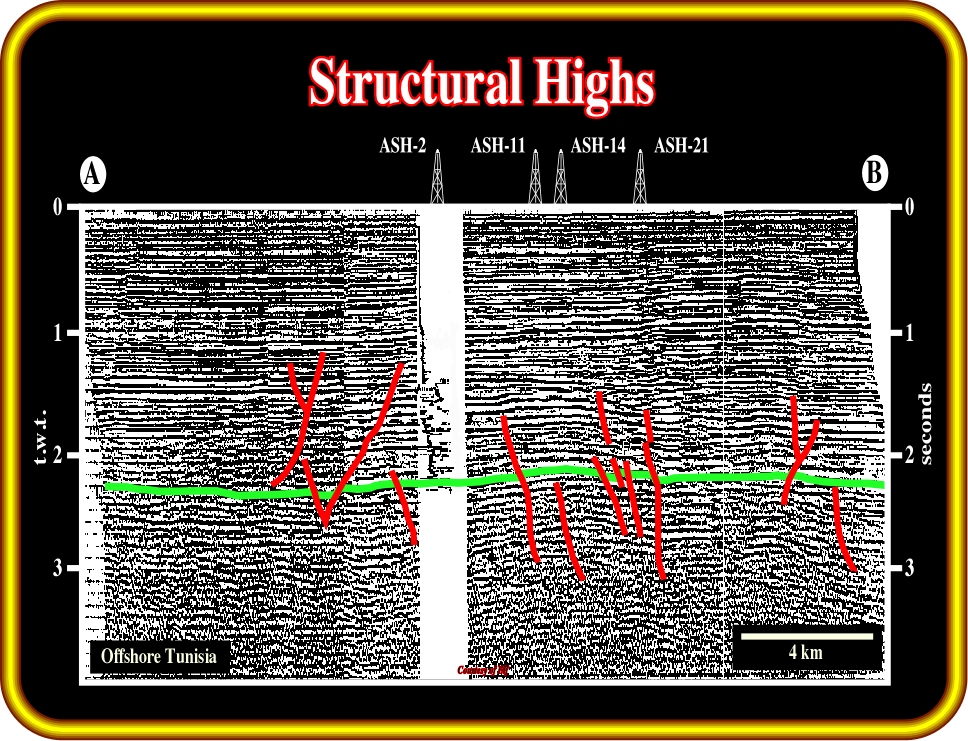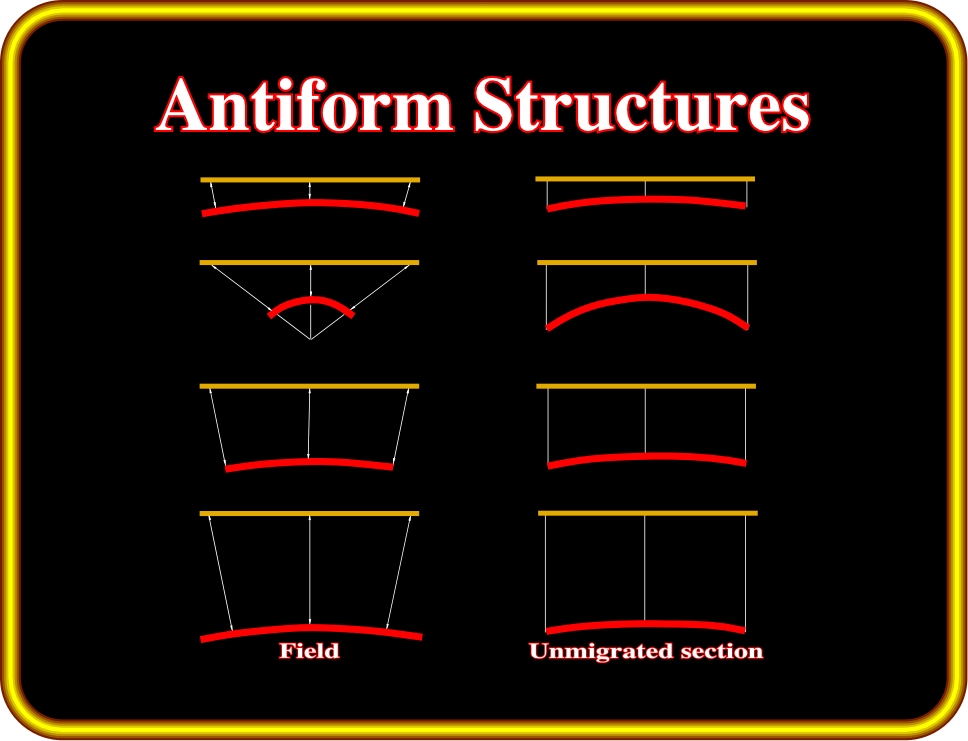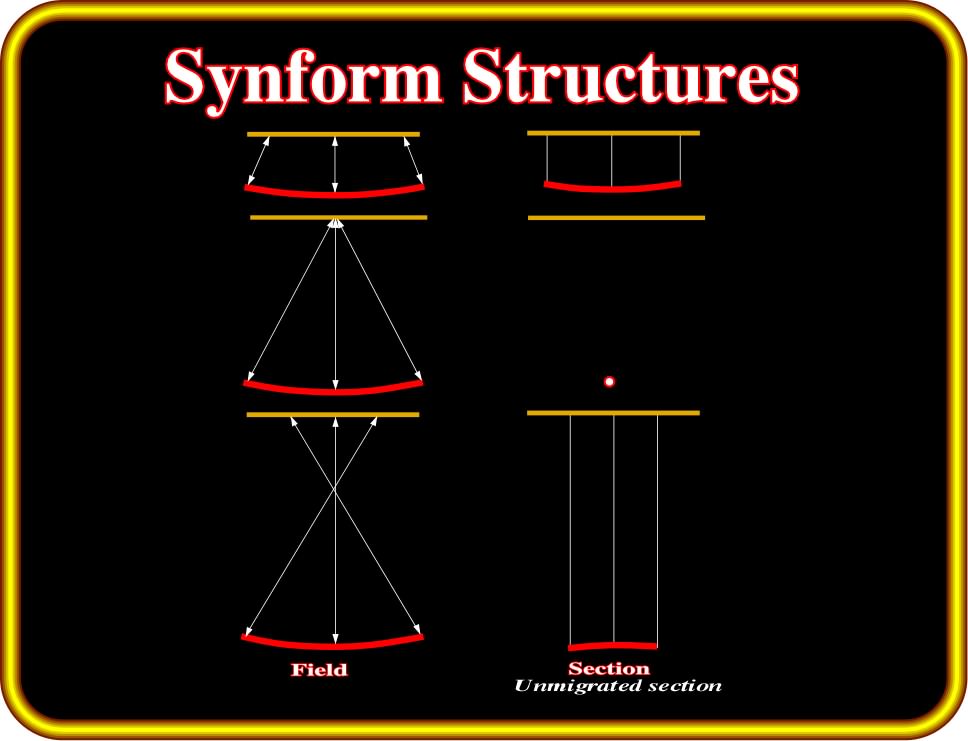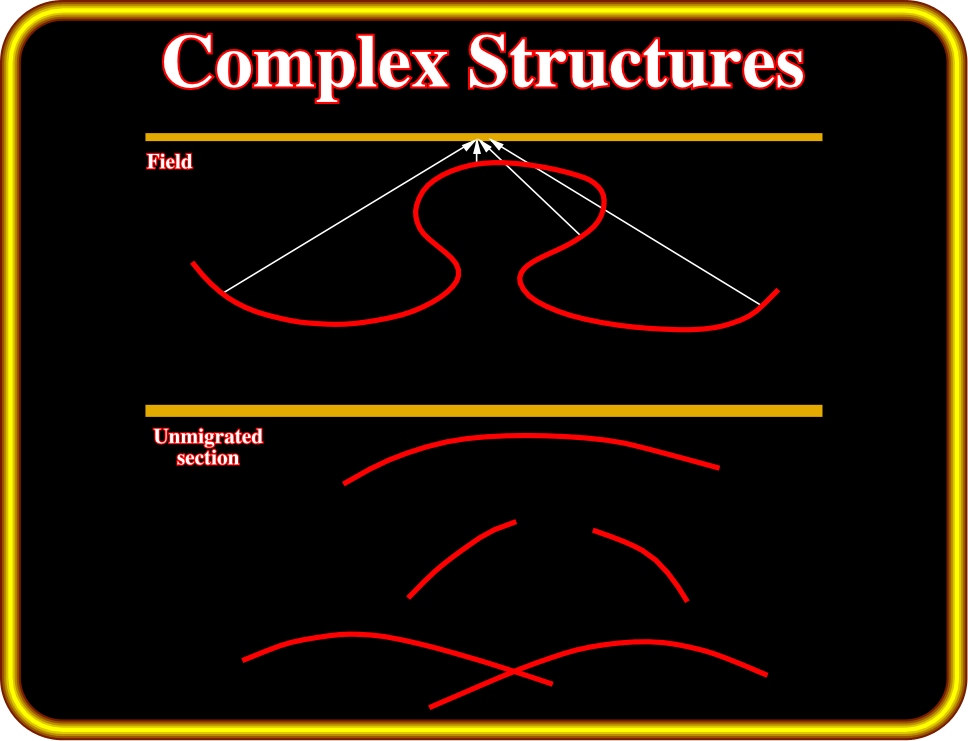
Universidade Fernando Pessoa
Porto, Portugal

Seismic-Sequential Stratigraphy
When interpreting a seismic line, interpreters must take into account that (i) generally they work with time section and not with depth sections, and (ii) artifacts should remain after, or even could have been generated by seismic processing. Actually, if horizontal and vertical subsurface velocities were everywhere constant, a seismic line section would be the exact image of its underlying geological cross-section. However, under such conditions seismic profiles would show no reflections at all. Fortunately the real world is different:
- Firstly, ground compaction of stratigraphic layers under their own weight causes velocities to increase naturally with depth.
The deeper the depth of burial of a geological level the faster is the velocity of propagation of the acoustic waves through it. One second (t.w.t.) of a shallow section, with a velocity of 2000 m/s, represents 1000 m of geological section. Hence, seismic time-sections are progressively squashed from top to bottom.
- Secondly, seismic velocities also depend on horizontal and vertical varying lithology. These variations are superimposed on the normal vertical distortion due to compaction.
The only way to view true scale seismic is to convert time-sections into depth sections. This implies a good understanding of the local velocity field and, the use of an iterative velocity model (as for depth migration).
E. 1) Time sections versus depth sections
In order to understand the difference between a time section (seismic line) and a depth section (geological cross section), let's consider a typical geological model, taken from Kwanza basin (Angola), and based on several wells’ results and field cross-sections (Plate 46).

Plate 46- On this geological model, taken from offshore Angola, above the basement (which often corresponds to a Paleozoic fold belt) rift-type basins were developed during the rifting phase, preceding the break-up of the lithosphere. Overlying the break-up unconformity there is an Atlantic-type divergent margin. A more or less continuous salt layer and a limestone platform were deposited in the lower part of the margin. Subsequently, lateral variations in velocity intervals are quite frequent, as illustrated here. Particularly interesting is the velocity change between the platform limestones (± 4500 m/s) and the coeval slope shales (± 2000 m/s), since it induces quite sharp artifacts in seismic lines (see next).
It is interesting to note that in this cross-section there are sharp lateral and vertical changes on the velocity of the seismic waves through the sediments:
- Through the sediments associated with rift-type basins, mainly organic rich shales and sandstones, the seismic waves travel at relatively low velocity.
- Overlying the type-rift basin sediments, an evaporitic interval was deposited with a basal limit more or less horizontal but showing significant thickness changes.
- The seismic waves travel through the evaporitic interval with a very high velocity around 5500 m/s.
- Above the evaporites, limestones were deposited in the landward part of the section, whereas in the distal part overpressured slope-shales overly the evaporitic layer.
- Finally, in the upper part of the section, an undercompacted shale-sand interval was deposited (1800-1900 m/s).
- Briefly, the velocity of the seismic waves through these facies are quite different as indicated in Plate 46 (4500 m/s, 2600 m/s, 5500 m/s, 2000 m/s and 1800 m/s). Through the sediments of the type-rift basin, mainly organic lacustrine shales and sandstones, the seismic waves travel at relatively low velocity.
The seismic synthetic response of this geological model is illustrated in Plate 47. It depicts the difference between a geological cross-section (depth section) and a seismic line (time section).

Plate 47- This time section is the synthetic seismic response (time section) of the geological model illustrated on Plate 6. The red marker corresponds to the interface basement/sediments, that is to say, the top of the basement. However, it does not correspond to a real chronostratigraphic line, but to an unconformity, i.e., an erosional surface. The brown marker fits with the bottom of the evaporitic interval, while the violet emphasizes the top of the evaporites. The light brown and the yellow markers correlate with the bottom and top of the undercompacted shale/sand interval. The pull-up of the horizon emphasizing the bottom of evaporites (brown marker) is a consequence of the high velocity of the seismic waves through the salt interval. The interval, between the violet and brown markers, corresponds to the limestone platform and slope shales. The high velocity of the seismic waves in the limestones is the responsible for its small time-thickness (eastern part of the time section). In contrast, the low velocity of the seismic waves through slope shales explains their large time-thickness (western part of the violet/brown interval).
Indeed:
a) Similar interval time thicknesses can correspond to quite different interval depth thicknesses. They are dependent of the velocity of the seismic waves through on each interval.
b) The geometry of the boundaries of the sedimentary packages can be quite different.
c) In time, the base of the evaporitic interval is not horizontal, as in the geological model, but strongly deformed by the lateral velocity changes.
d) The top of the basement shows an antiform geometry under the change of facies from limestones to shales.
Let‘s see some real examples:
Example n° 1- This example comes from the west Palawan offshore (Philippines), where, in the 70’s, several companies explored the conventional offshore (< 200 m):
(i) One wildcat was supposed to test the hydrocarbon potential of a structural high.
(ii) The structural high was identified on unmigrated seismic lines.
(iii) The seismic line where the wildcat was located is illustrated in the upper part of Plate 48.
(iv) On the seismic line (time), the structural high is located directly above the present limit between continental shelf (<200 meters water depth) and the upper slope environment, i.e., above of an abrupt change of water depth.
(v) The structural high was interpreted as a potential reef anomaly located nearby a shelf break (depositional coastal break is far away landward, the basin, at that time, as today, had a platform).
(vi) A wildcat was drilled and suspended 200 meters below the apex of the structural high of the potential reservoir-rock (upper part of Plate 47).
(vii) The results of the well were totally negative. Indeed, no indications of hydrocarbons and no reservoir-rocks were recognized.
After the negative results of the well, a depth-migration of a few seismic lines line was performed. A depth-time conversion of the line where the well was located is illustrated in the lower part of Plate 48.

Plate 48 - In the upper part, an unmigrated time version of a seismic line, where a wildcat was located, is illustrated. In the lower part, the depth migrated version of the potential reservoir-interval. The depth version strongly suggests that the time-structural high corresponds to a seismic artifact and not to a real antiform structure (extension). In other words, the prospect is not a structural trap, but a morphological trap by juxtaposition. Indeed, explorationists not only forgot the west Palawan offshore is located within the Meso-Cenozoic megasuture, that is to say, located in a compressional geological setting, but also they did not take into account that an increasing water-depth induces an increasing pull-down of the seismic horizons.
Comparing the two versions, explorationists readily understood:
The time-structural high corresponds to a seismic artifact induced by the water depth change and facies change in the sediments overlying the potential reservoir-rock.
Example n° 2
The next example comes from offshore Tunisia. It illustrates what interpreters should not do when assessing expected producing reserves in an oil or gas accumulation. In other words, interpreters should never forget:
a) The difference between a seismic line and a geological cross section.
- A seismic line corresponds to a time-profile.
- A geological cross section is a depth-profile with, or without, vertical exaggeration.
b) That they must test (criticize) all proposed geological interpretations of a seismic line.
- The more coherent and realistic interpretations is not the nicest, or its own, but the more difficult to refute.
Actually, the philosophy of the seismic interpretation, as well as, other geological interpretations, can be summarized as follows:
(i) At the beginning, explorationists have a “problem” (find hydrocarbons, for instance).
(ii) in order to solve the problem, they must propose, or advance an “hypothesis” (interpretation), what implies a certain a priori geological knowledge.
(iii) Then, they must try “to refute the advanced hypothesis”. Such refutation test can be done with new or old observed data.
(iv) Arriving at this point, two possibilities can be considered:
a) The refutation test failed. Hence, with the available data, the interpretation can be considered as probable, i.e., the hypothesis is corroborated by the available data, but is not true. New data can refute it. In other words, there is no true seismic interpretation.
b) The interpretation is refuted. In this case, again the interpreter gets a new “problem”. The new problem implies a changing of the “initial hypothesis”. A “new hypothesis” must be advanced, which afterward must be “tested” and so on.
This scientific approach by trials and errors is the best way to make substantial progress in geological sciences and seismic interpretation.
In this example (Plate 49), the same seismic pitfall, which can be reported as follows:
On time seismic profiles with lateral changes in velocity interval, the highest time-structural point of a seismic marker does not necessary correspond to the highest depth-structural point.

Plate 49- Take note that this seismic line comes from the offshore Tunisia, i.e., from an area located inside of the Meso-Cenozoic megasuture. In addition, the lengthening of the Pangea sediments seems to have been big enough to breakup the lithosphere creating an oceanization. Briefly speaking, the basin setting is that of Mediterranean-type basin (globally compressional). On this line (time section), it is easy to recognize that the highest time structural point along the picked reflection (green marker) is near the well ASH-11. However, as shown later (Plate 51) due to lateral facies and velocity changes, this time structural point does not correspond to the highest depth structural point.
Indeed, on a time-seismic line (from now on, a seismic line expresses a time-seismic profile) not all time-structural high points correspond to depth-structural high points. Explorationists in charge of the offshore Tunisia, using untested geological interpretations of the seismic lines, proposed to their management time contour maps of the top of the potential reservoir (green marker on Plate 49), in which a small structural closure was visible (Plate 50). The Management decided to test such a structural closure. The results of the well were positive, i.e. hydrocarbons were found on the predicted reservoirs.

Plate 50- Before the drilling of well ASH-21, the depth contour maps of the field were similar to the one illustrated on the right of this figure and the structural sections of the reservoir-rock (in green) as the one illustrated on the right. The highest structural point was located westward of ASH-14, eastward of the proposed location of ASH-21. However, the results ASH-21 indicated the actual highest depth point was located westward of ASH-21, at 2644 m (in red). These results completely refute the proposed time geologic interpretations of the field, which, by the way, were mainly based in the picking of the top of the reservoir interval. Indeed, as shown next, it seems explorationists forget that a particular interpretation (picking just one marker) must fit within the global geological picture. Actually, in Geology, and particular in Petroleum Geology (Petroleum Systems), explorationists progress from the general to the particular and not from the particular to the general.
After drilling, explorationists took the positive results of the wildcat as a “verification” of their geological interpretations of the seismic lines. Such an attitude is highly dangerous (verificationism). The consequences can be catastrophic. In fact, a geological interpretation can never be “verified” (in Latin verus means true). Indeed, as said previously true geological interpretations do not exist.
The verification of a geological interpretation is impossible.
Interpretations can be either corroborated or validated, by certain data, but that does not mean the interpretations are true.
Following this erroneous attitude, several wells were proposed and drilled with successful results and a development phase took place. At that time, before the drilling of ASH-21, the structural sketch of the field at the reservoir level, assumed by the explorationists, was similar to that illustrated in Plate 50. Actually:
- Before the drilling of ASH-21, the converted seismic depth map calibrated with the results of the wells (Plate 50), indicated the highest structural point slightly (800-1000 m) eastward of ASH-14, as shown in the cross section AB (green marker).
- The well ASH-21 was proposed and the predicted depth of the top of the reservoir-interval was at 2744 meters in depth.
- After the drilling of ASH-21, surprisingly, the top of the reservoir-interval was found 100 meters higher and the apex of the structure was not located 800-1000 m westward of ASH-14, but around 1000 m westward of the well ASH-21.
The substantial increasing of the hydrocarbon “reserves” following the drilling of ASH-21 masked the mistake made by the seismic interpreters. Nevertheless, the understanding of the surprising results of well ASH-21 became extremely important in order to avoid future mistakes. The interpreters forgot a seismic line is a time section and not a depth section. Lateral lithological changes, above the reservoir-rock, must be taken into account during the interpretation, since they induce lateral velocity changes, which, in a depth section, can invert the relative position between two points:
In a time section, a relatively high structural point can become a relatively low point, in a depth converted section, function of the interval velocities.
Plate 51- This line corresponds just to an enlargement of the line illustrated on Plate 50. It shows a transgressive backstepping-interval (in green) thinning seaward. Such a thinning corresponds to a lateral change in facies and so, in velocity. The different time-thickness of this transgressive calcareous interval, drilled in ASH-2 and ASH-21, readily explains why the highest time-structural point of the potential reservoir (lower green marker) does not match with the highest depth-structural point: the seismic waves do not travel at the same velocity in limestones and slope shales. The markers below the slope shales are pulled-down.
The interpretation, in sedimentary packages and not just following single and more or less continuous reflections, of the seismic line (Plate 49) strongly suggests a sedimentary interval between 1.5 and 1.75 seconds in the left part of the line (colored in green on Plate 51):
- This sedimentary package thins leftward and becomes very condensed near the location of ASH-21.
- Such a geometry is associated with a transgressive episode, which deposits thickens landward as the depositional coastal break backsteps and the water depth increases creating a larger shelf (platform).
In fact, it is easy to recognize a lateral facies change:
- Seaward of the Oligo-Miocene shelf break (abrupt dip change in the green interval), the platform limestones are gradually replaced by more or less coeval slope shales.
- This change in facies (lithology) induces a seaward slowing of the interval velocity.
- Below the condensed limestones, near the ASH-21, seismic waves are delayed and the associated reflections (time) are pulled-down relative to those underlying the thick limestone package in the central and right part of the seismic line, which are pulled-up.
E. 2) Unmigrated versus Migrated Profiles
Multifold covered data display implies a geometrical approximation (Plate 52):
Source and receivers positions are removed artificially and placed on a same location by applying dynamic (or move out) correction.

Plate 52- Dip move out may be used to compute the reflector dip
if V (average velocity) is known. V can be derived by a mathematical equation using the NMO (normal move out, i.e. the difference between the travel times t1 and t2 of reflected ray arrivals recorded at two offset distance x1 and x2), which for small dips may be obtained with sufficient accuracy by averaging the up-dip and down dip move-outs.
- When a reflector is tilted, the reflectors paths arriving at two receivers, located at equal offsets up-dip and down-dip from a central shot point, are of different length. The rays will therefore have different travel times.
- Dip move out is defined as the difference in travel times tx and t-x of rays reflected from the dipping interface to receivers at equal and opposite offsets x and -x.
- The steeper a reflector is the greater is its dislocation on an unmigrated time section.
Migration (Plate 53) is the process of reconstructing a seismic section so that reflection events are repositioned under their correct surface location and at a corrected vertical reflection time. In order to migrate a seismic section accurately, it would be necessary to define fully the velocity field of the ground, i.e. to specify the value of velocity at all points. In practice, for the purposes of migration, an estimate of the velocity field is made from prior analysis of the unmigrated seismic section, together with information from borehole logs.
Plate 53 - For a given reflection time, the reflection point may lie anywhere on the arc of a circle centered on the source-detection position. On an unmigrated seismic section, the point is mapped to lie immediately below the source-detector. In a migrated line the point is repositioned under its correct surface location and at a corrected vertical reflection time.
Migration also improves the resolution of seismic sections by focusing energy spread over a Fresnel zone and by collapsing diffraction patterns produced by point reflectors and faulted beds. In addition, migration removes the diffracted arrivals resulting from point sources, since every different arrival is migrated back to the position of the point source.
Although, nowadays, the majority of the seismic lines used in petroleum exploration are migrated lines, it is interesting to make a review of the major differences between migrated and unmigrated data in order to understand not only the evolution of geological interpretation of seismic profiles, but the organization of the exploration teams as well.
A) Antiform Structures
Since a seismic section (unmigrated) presents its trace vertically below the observation point, it is evident that the seismic line will portray antiform structures a little wider than in the ground (Plate 54). In other words, the flanks of the structures are less steep. However, the crest of the structure is always in its correct positions with respect to the surface. Hence, crestal areas, with their low dips, are the least distorted areas.

Plate 54 - These sketches illustrate the seismic responses of antiform structures with different geometries. It is easily to notice that on unmigrated seismic lines the closed surface associated to antiform traps is always overestimated. Indeed, in the 70‘s, before the migration advent, the misunderstanding of this important feature could have catastrophic consequences. I remember quite well, as the majority of the large, and apparently economic prospects of Labrador Sea (based in unmigrated data) disappeared, as the first migrated versions of the seismic lines were performed.
The seismic answer of real earth antiform structures (anticlines and rollover) on unmigrated seismic lines (Plate 54) was summarized as follows (A. Fitch, 1979):
(i) A gentle antiform is scarcely changed in its seismic expression.
(ii) A sharply folded, narrow antiform may have seismic expression as a gently folded, wide antiform.
(iii) The antiform will show less relief on the seismic response.
(iv) A given antiform shape will have a wider seismic expression the deeper it gets.
(v) Concentric anticline folds are parallel folds on seismic lines.
(vi) Widening in depth of parallel folds can progress to the point where neighboring anticline folds can overlap in their seismic expression.
B) Synform Structures
Gentle synforms present few problems (Plate 55). Synforms become a little narrower on seismic than they are in fact. The lower point of the synform is undisturbed.

Plate 55- The illustrated relationships can be stated in terms of the position of the centre of curvature of a cylindrical real synform (field): (i) when the centre of curvature is above the surface, the synform response is concave upward; (ii) when the centre of curvature is at surface, the response is a point and (iii) when the center of curvature is in the subsurface, the synform response is convex upward.
A. Fitch (1979) summarized the seismic response (Plate 55) of a concentrically synforms as follows:
- Concentric synforms appear as parallel folds in the seismic response.
- With parallel folding in the real earth, the deeper the synform reflector considered the narrower its seismic response.
- A depth is reached, eventually, at which the seismic response of the whole synform is a single bright point. Below this level, the normal to deepest part of the synform is shorter than the normal to any point on the flanks of the synform, that is to say, the seismic response of such synform is convex upward, that means it looks like an antiform at first glance .
C) Complex Structures
Compression and intrusive bodies create complex structures that have seismic responses that are often difficult to interpret (Plate 56). The intrusive material may be: salt, mobile shale, or volcanic. As, in many cases, sedimentary beds are strongly deformed around the top of the intrusive body, droopy hyperbolas obscure the flank structures deeper down.

Plate 56- This sketch illustrated how complex is the answer of complex structures, here a salt dome and its associated rim synclines, in an unmigrated seismic line. This was probably the main reason why before the advent of migration, the majority interpretation of the seismic lines was performed by explorationists with a geophysical background.
In most cases, intrusive bodies have a piercement relationship, hence sedimentary beds, which are cut across, show typical fault features. Salt domes, being usually flanked by rim synclines, form very complex structures, which yield seismic responses that, at first, seem unrecognizable.